Last Updated on March 17, 2025 by Owen McGab Enaohwo
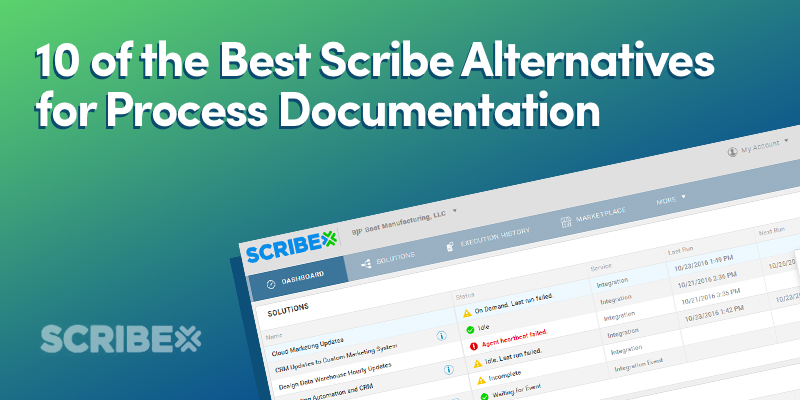
It can quickly become tiring to describe and explain the same process to every new employee who joins your company. You could spend that time doing more high-value tasks—maybe taking discovery calls or networking with other business owners. Process documentation software allows you to be more efficient.
But there are many documentation software solutions in the market. And if you’ve checked out Scribe, one of those software solutions, you already know that its not-so-modest $29/user/month pricing, coupled with features that don’t work well, make it a discouraging buy.
It shouldn’t be expensive for you to create simple processes. It shouldn’t be so expensive to onboard new hires. It definitely shouldn’t be so costly to show new clients your processes and onboard them.
If leanness is important to you, then you’re likely on the hunt for the best Scribe alternatives.
To help you choose, we’ve compiled a list of the best Scribe alternatives. We’ll explore their features and pricing, and give each a final verdict so you can choose something that meets your needs.
Meanwhile, check out SweetProcess and its robust features here.
But First, What is Scribe?

And what does it do?
Scribe is a workflow documentation platform that allows its users to record digital processes (movement and clicks on screen) and then converts these movements and clicks into step-by-step guides complete with screenshots and text that team leads can edit and share.
These recordings (called Scribes) can be made from a Chrome extension or the proprietary desktop app and shared with specific teams and/or individuals. With software like Scribe, you can quickly and easily create documentation that anyone can use. You can also easily handle tasks like employee onboarding and knowledge base creation.
All Is Not as Good as It Appears, However

Although Scribe is relatively intuitive and easy to use, it has three serious limitations that make it a discouraging buy for most businesses.
The first is pricing.
Although it’s a good introduction to their software, Scribe’s free plan is severely limited. For one, you can only make recordings using web-based apps. To make recordings of desktop applications, you need to buy the Pro version, which costs a jaw-dropping $29/user/month.
You also won’t have the ability to crop screenshots and redact text unless you upgrade to the paid plan. And if you’re sharing screenshots containing sensitive information, this could be a big issue.
The second deal breaker with using Scribe is its inability to handle longer complicated processes. Some users have attested to having problems with the oversimplified way it handles processes.
Industries like manufacturing, which require long detailed technical processes, will have no use for Scribe because Scribe works best when you want to demonstrate how to execute simple processes that require recording your screen.
On top of that, users complain of not being able to connect Scribes for longer, more complex processes.
For businesses that have multiple complex processes, Scribe isn’t a viable option.
Most importantly, the software is a work in progress. The functionality of the software is limited. One such limitation is in editing text. Making certain words or numbers stand out without bold, underline, or italics can be a bit of a challenge for some users.
Clunky dashboards are another issue.
The software has limited compatibility with other platforms and UX roadblocks.
These seemingly insignificant things make paying $29/user/month questionable.
These Are the Best Scribe Alternatives
The proof is in the pudding: How a CEO Reduced Employee Turnover with SweetProcess
SweetProcess
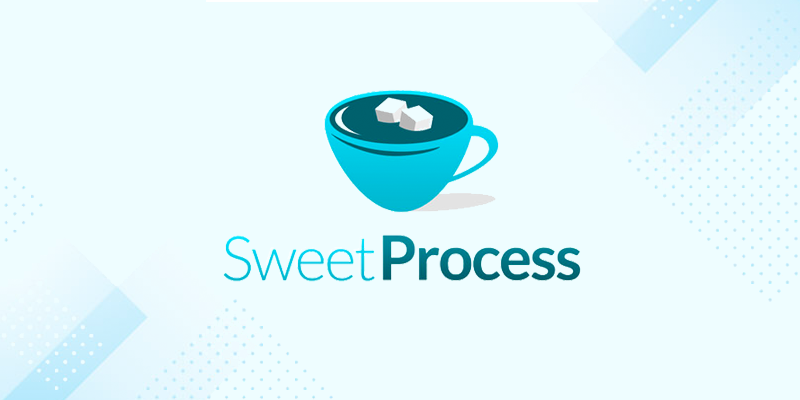
Yes, our solution is the first on the list because it’s our blog.
And also because our software is awesome.
SweetProcess is a robust software that does more than process documentation for less money. Along with letting you easily create long complex processes with multiple steps, you can create knowledge bases and pen the policies that will shape the future of your company.
In case you’re swamped, and don’t know exactly what everyone is up to, SweetProcess allows you to assign and track tasks so you can stay organized and in-the-know.
How much does it cost to use such robust software?
$99/user/month
$49/user/month
$29/user/month
The way our pricing is set up, you only spend $5 per team member. If you pay an annual subscription, you pay even less. This pricing is ideal for small teams. It is also cost-effective for large teams. More details about pricing later.
For now, here’s a deep dive into the core features that make SweetProcess truly special.
The Six Sweet Pros of SweetProcess

- Procedure documentation: You can easily create procedures to give your team directions to do literally anything.
- Process documentation:Moreover, you can link multiple procedures together to create comprehensive workflows, especially if the process is long and complicated. SweetProcess provides all the functionality you need. You can document simple and complex processes alike.
- Process map:To help with creating processes, SweetProcess has a process map feature that allows team members to visualize the flow of processes with flowchart diagrams that are easy to follow.
- Policy documentation:Policies shape how work is done at your company. You can easily document your core policies and share them to keep everyone in the know. Even better? You can directly link to policies from within procedures or processes to provide a seamless knowledge machine that works on autopilot.
- Knowledge base functionality:Knowledge is important for your business, both for your customers and your employees. With SweetProcess, you can create forward-facing knowledge bases for your customers, or you can create an internal knowledge base that could provide your team answers to common questions.
- Project management:Along with allowing you to document your policies and processes, you can use SweetProcess as a project management tool. You can assign tasks to members of your team and track their progress on those tasks. You never have to wonder what everyone is up to anymore.
Some more features that make SweetProcess a joy to use are:
- Integration with 1,000+ apps
- Image editor (edit, resize screenshots, and redact text at will)
- Real-time collaboration
- Access to version history so you’re never lost
SweetProcess Use Cases
Here’s how:
- To create processes in SweetProcess
- To create procedures using SweetProcess
- To link processes and procedures to create knowledge bases
Create Processes Using SweetProcess in 7 Simple Steps
Say you’re the hiring manager at your company.
How would you use SweetProcess to document the process of hiring candidates?
Step 1
Log in to your account. On the dashboard, navigate to the cute plus button beside “Processes” in the sidebar.
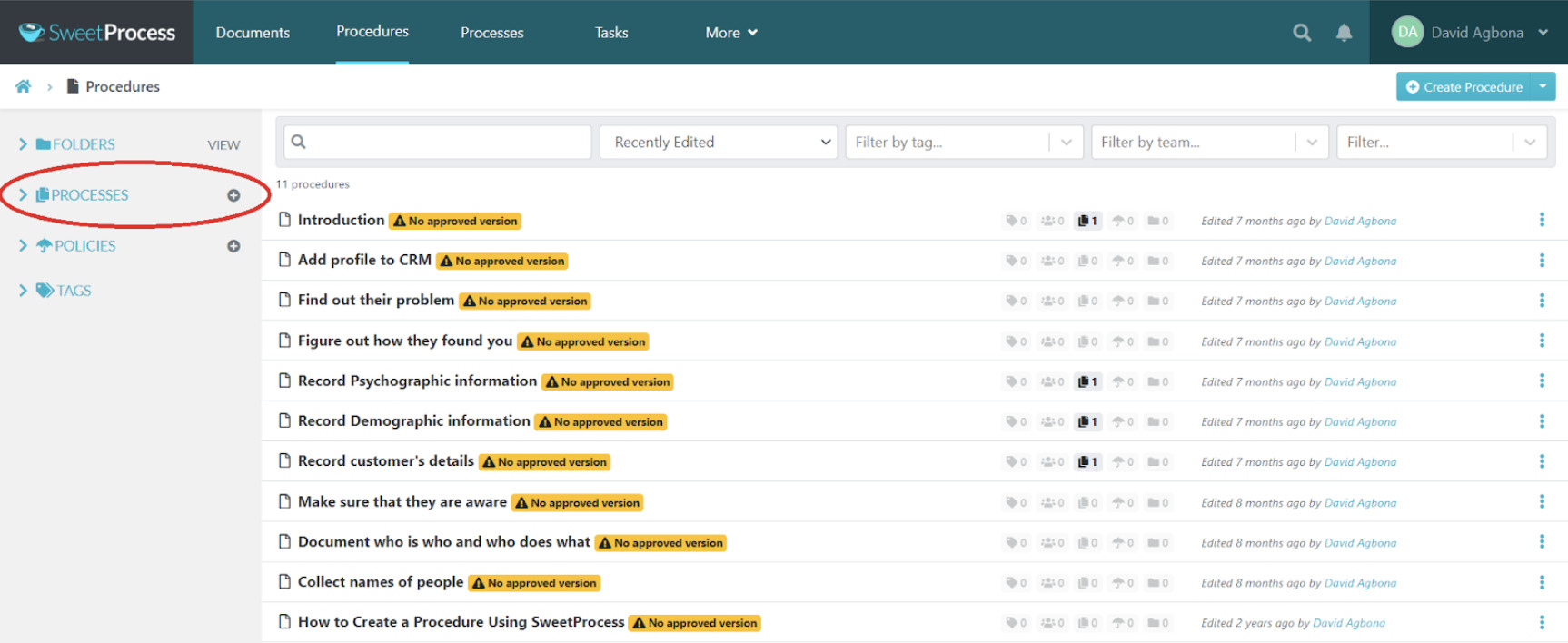
Step 2
In the empty field, enter the title.
You mustn’t skip this step. This seemingly insignificant step can keep you from being overwhelmed when you create more processes.

Step 3
After naming your process, proceed to outline the steps in the process by clicking the “Add Step” button.
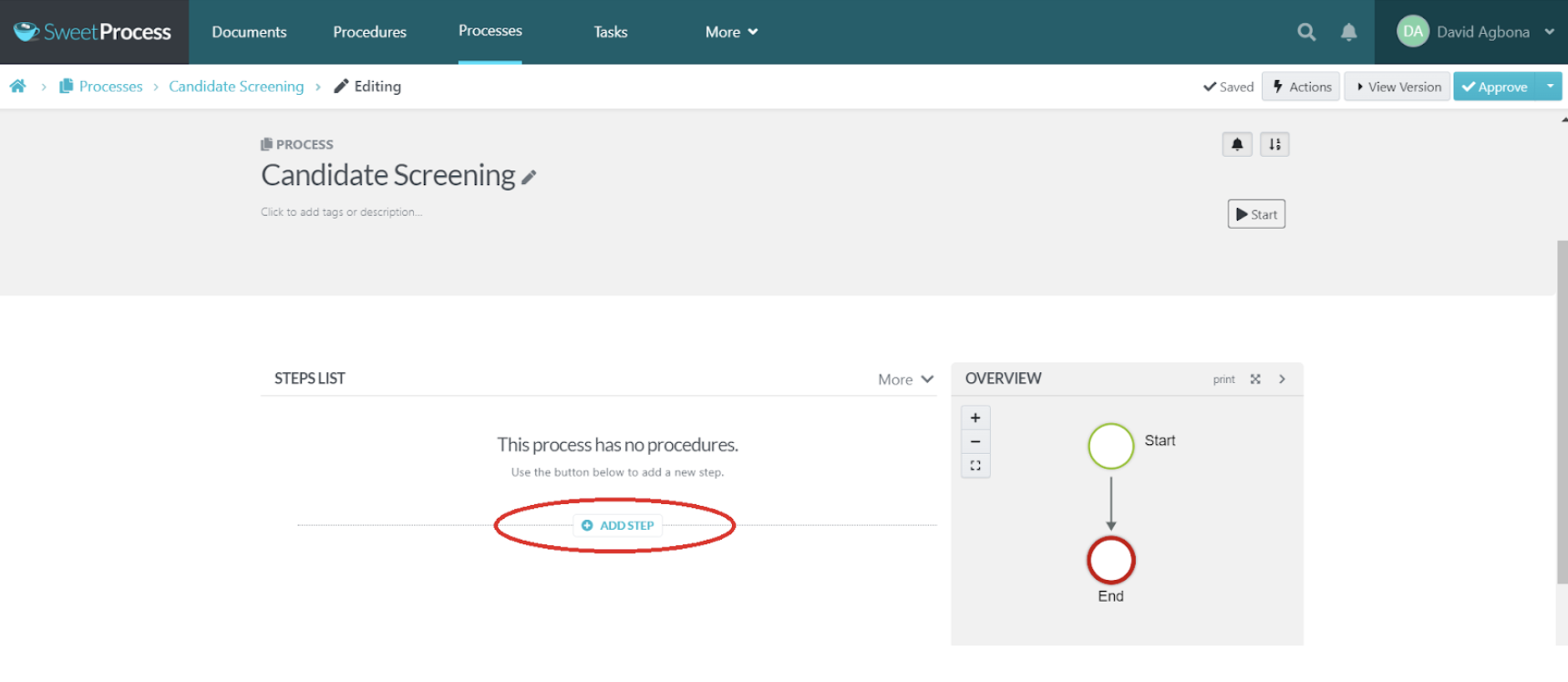
Step 4
When you click the “Add Step” button, three fields will appear.
To continue, click the “Procedure” button.
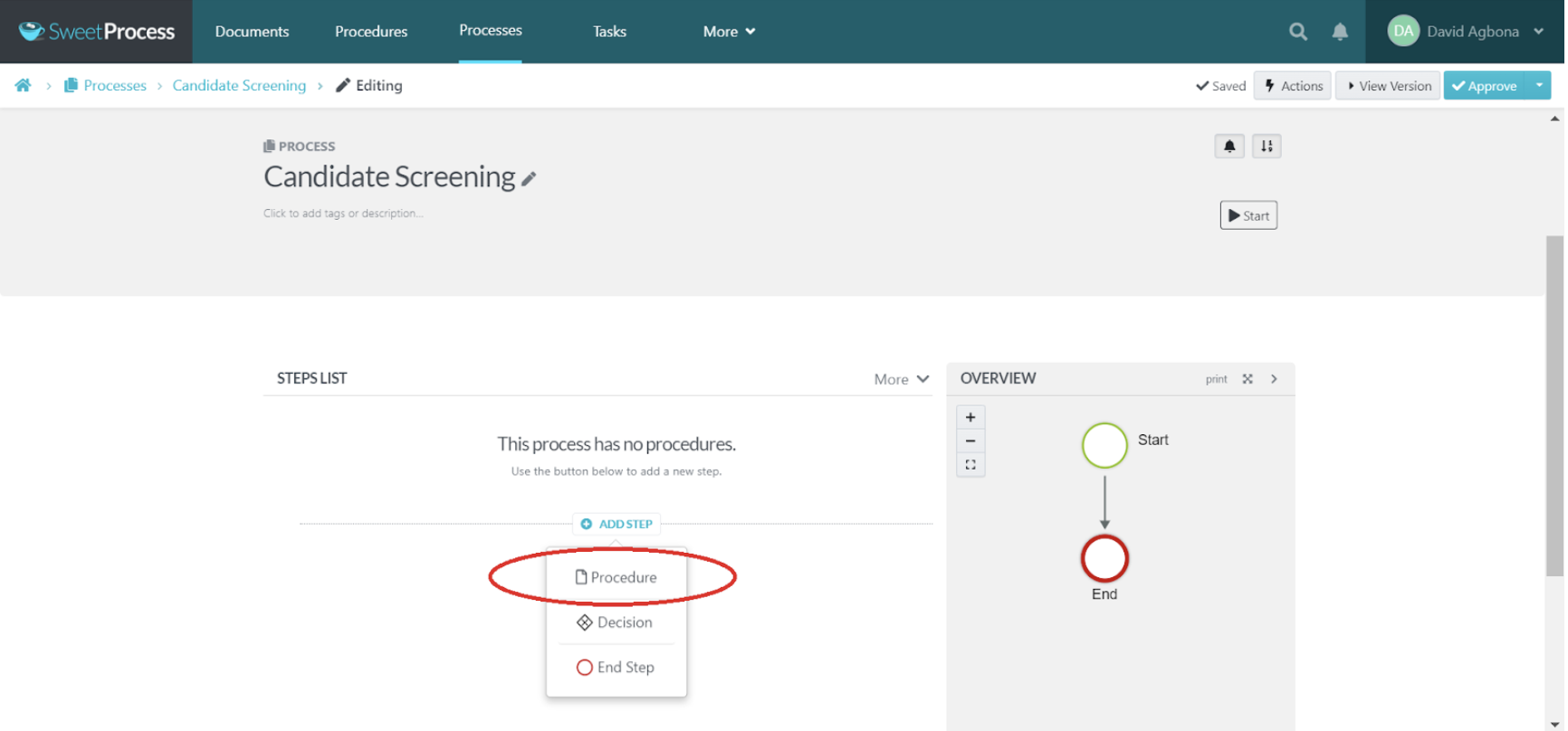
Step 5
Remember to title the step. This will keep you organized as you proceed.
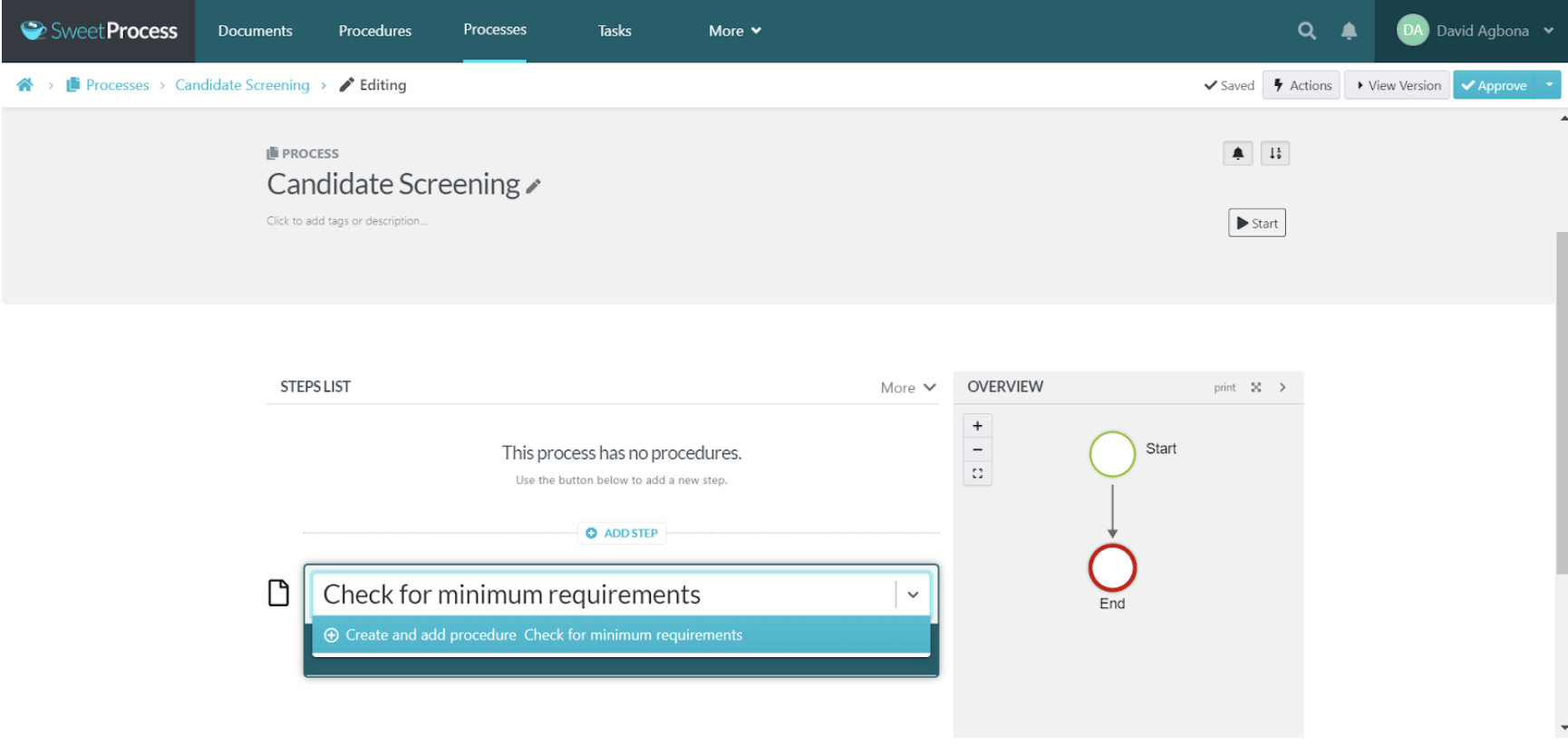
Step 6
Things become straightforward from here, merely a matter of rinse and repeat.
Repeat steps one through five to continue adding the steps you want.
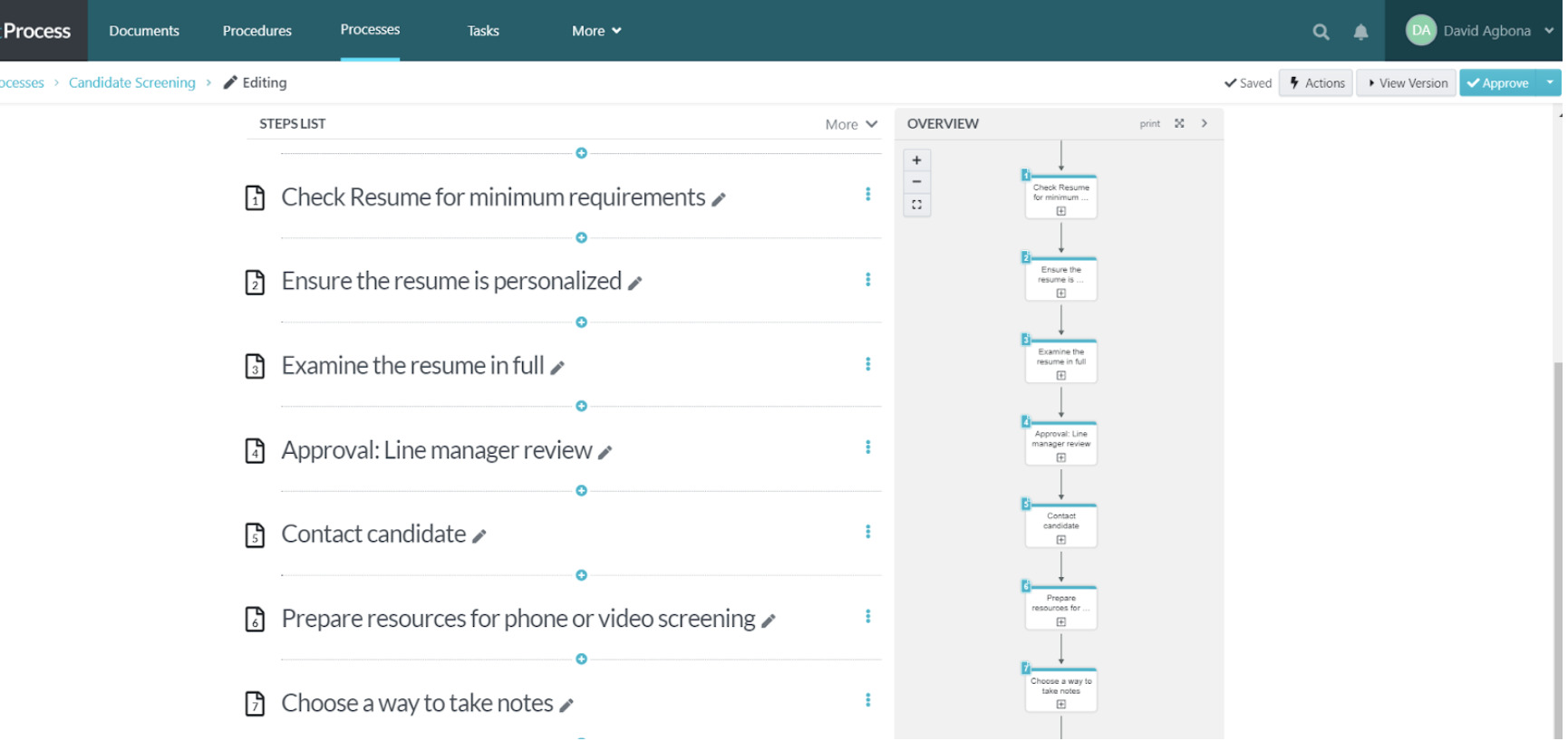
Step 7
When you’re done adding all the steps, approve the process so it goes live.
Depending on your role, you can either approve it yourself or request permission for approval and notify the rest of your team.

Voila! Your process is live!
Create a Procedure Using SweetProcess in Just 5 Steps
What happens when you’re done creating a process?
How do you flesh out the procedure or steps?
Step 1
Once again, navigate to the main dashboard (or homepage if you like).
Click on the “Procedures” header and choose the procedure you want to flesh out in detail.
We’ll use “Check for minimum requirements” in this example.
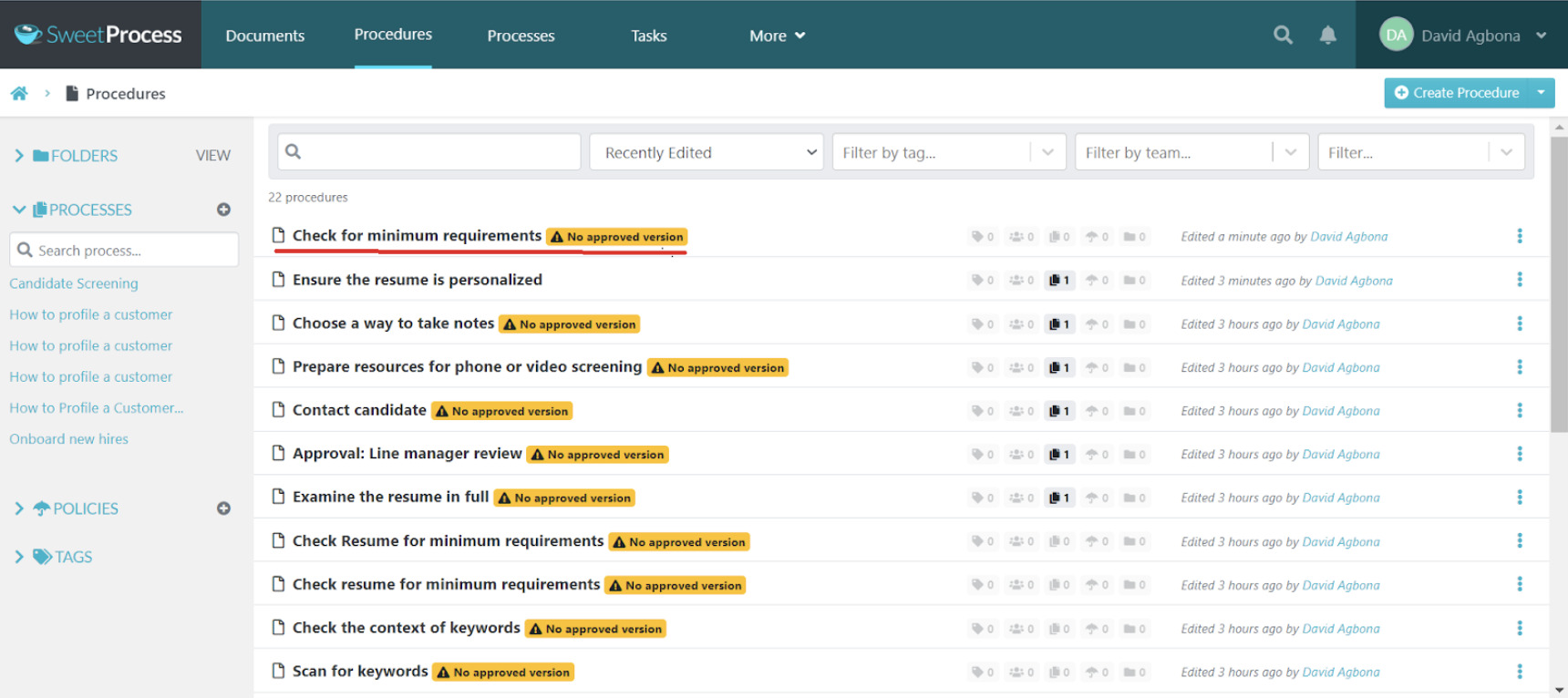
Step 2
Click on “Edit” in the upper right corner to add steps to the procedure.
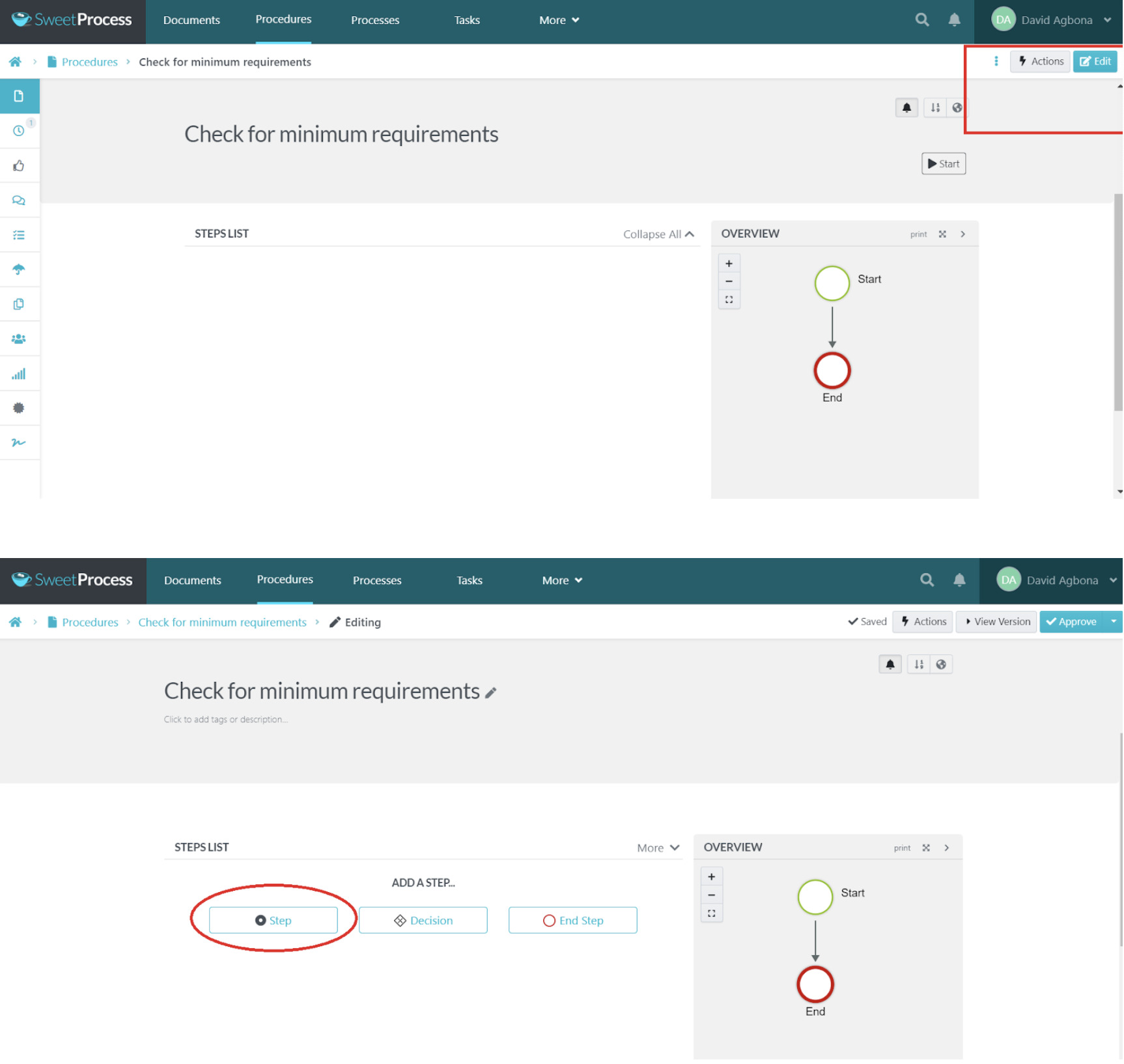
Step 3
In the open dialog box, title the step and write a description if more explanation is needed. Click “Finished Editing” when you’re satisfied with your input.
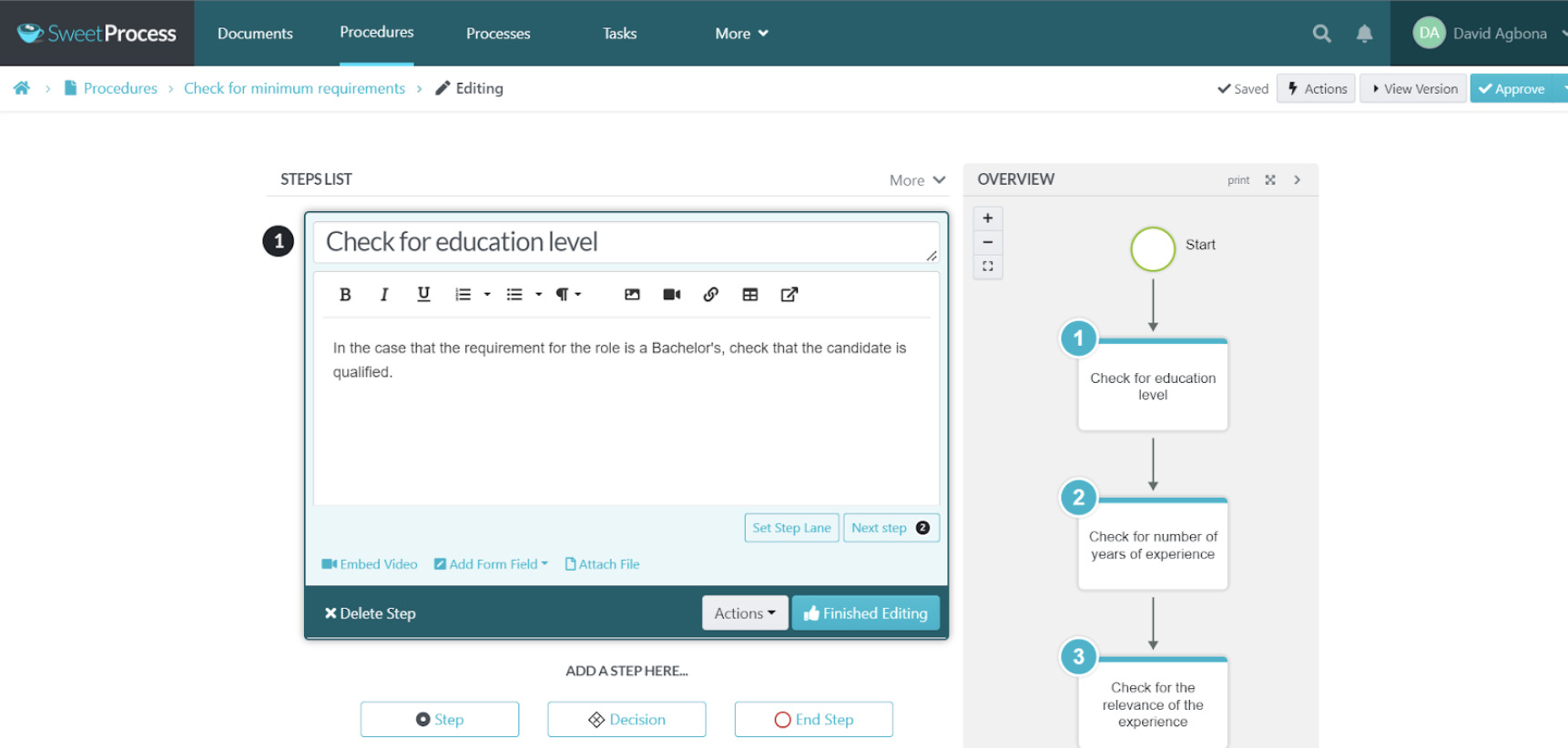
Step 4
Rinse and repeat to write all the steps you need.
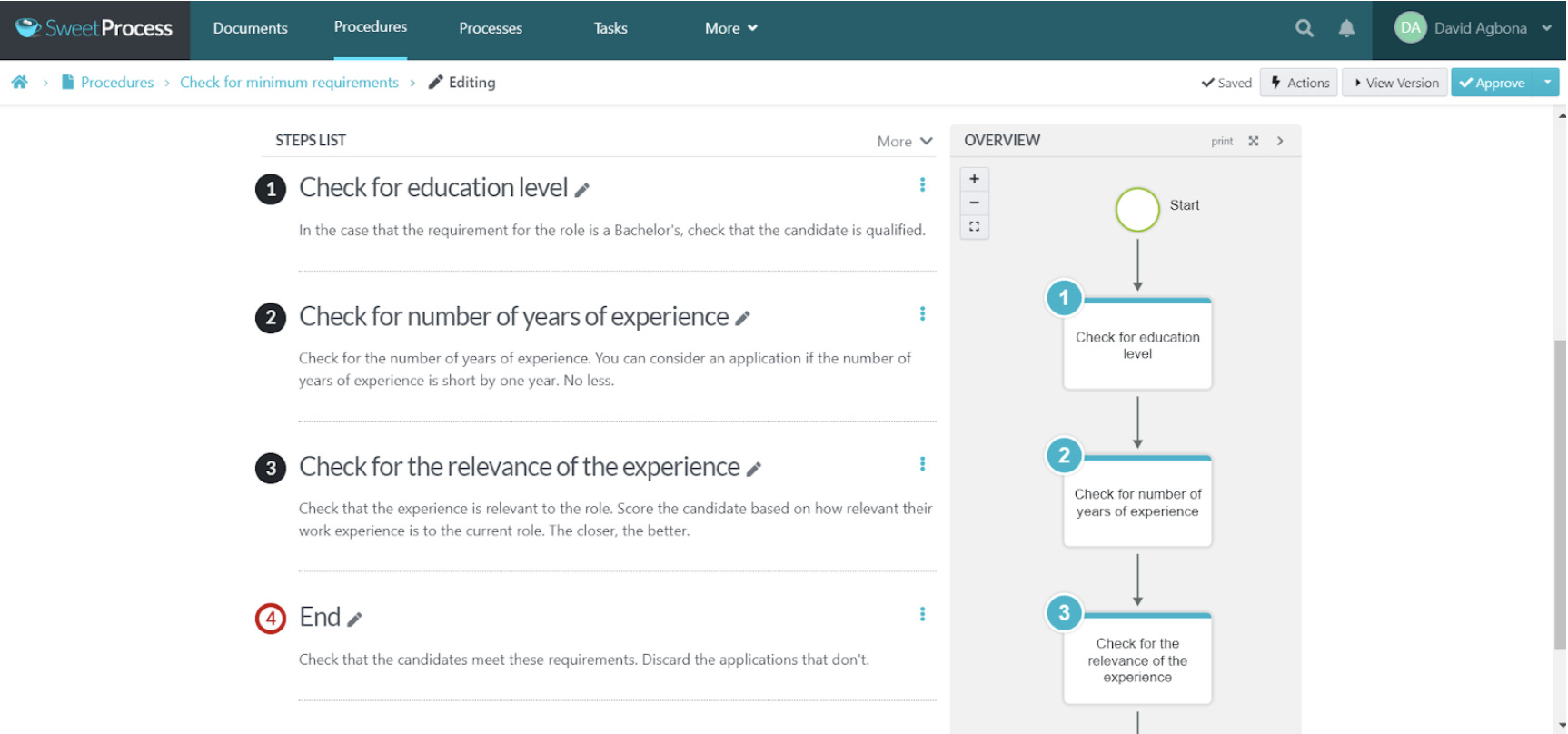
Step 5
Don’t forget to approve!
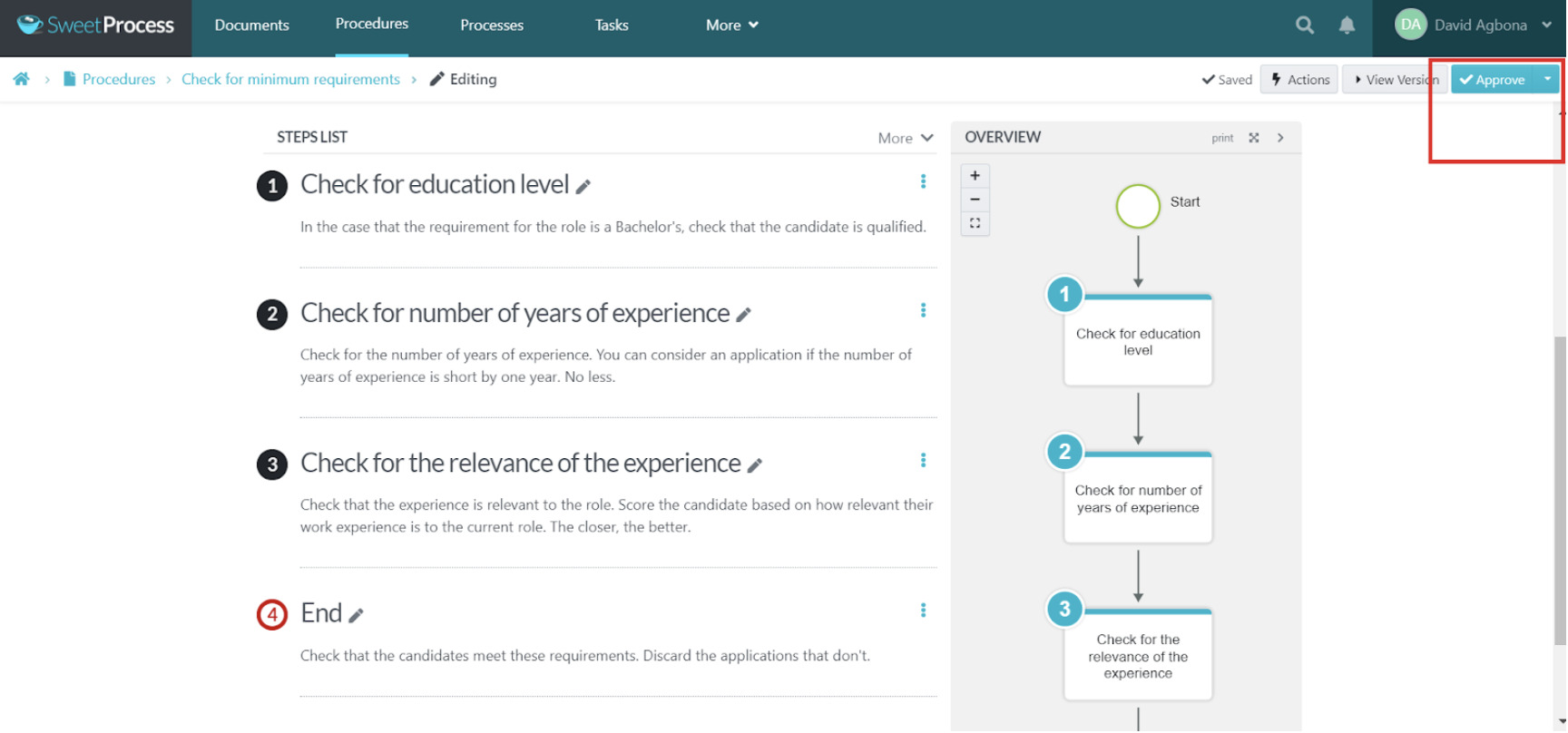
Create a Knowledge Base Using SweetProcess
These are the steps you’ll use to create a simple knowledge base for your customers.
Remember the hint that the above steps are tied together?
You’ll see how.
Step 1
Log in to your dashboard and click on “More” in the header. Select “Knowledge Bases.”
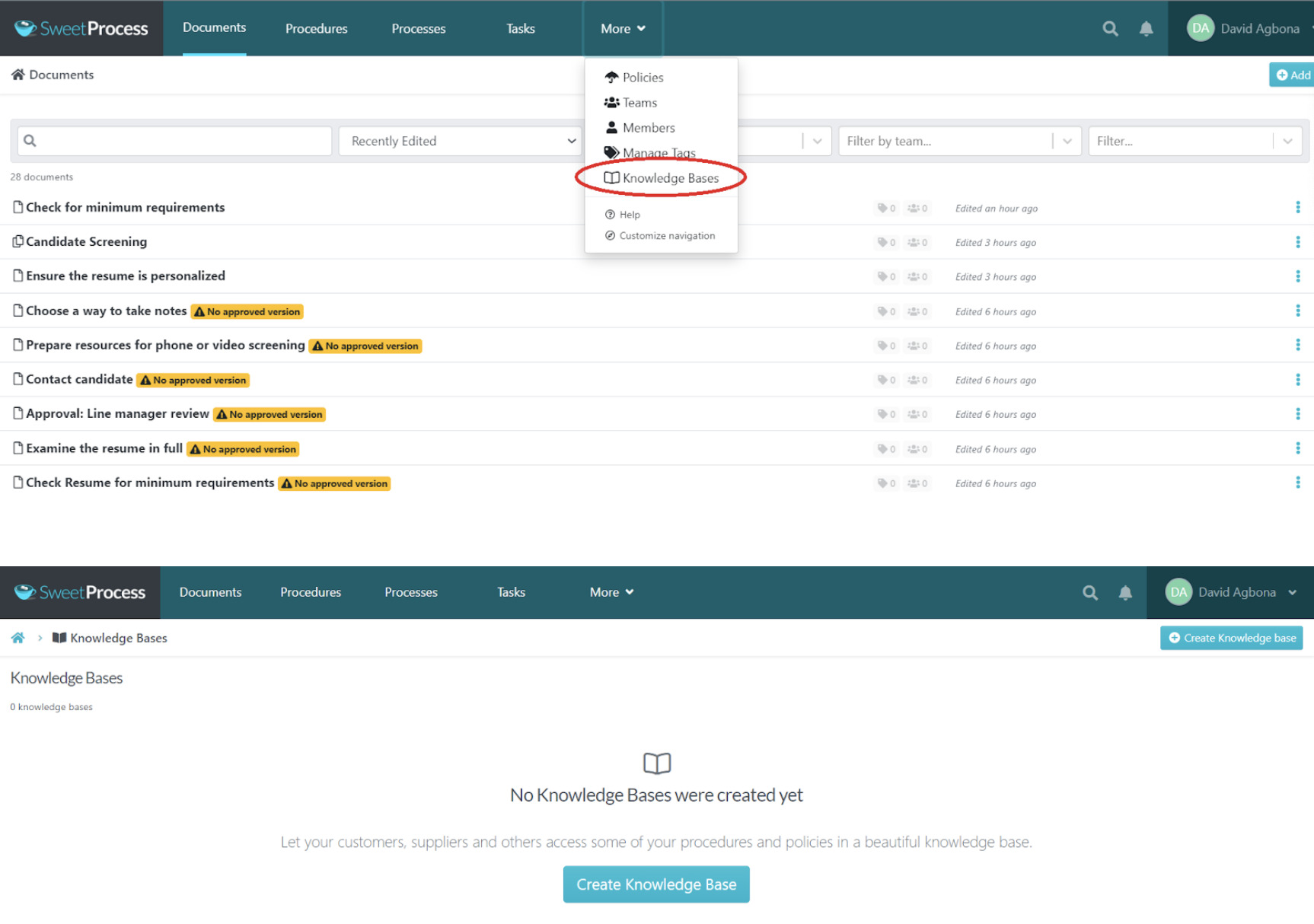
Step 2
Just like before, title your knowledge base to get started.
We’re really going to ride this “hiring” wave!

Step 3
The section above the fold is mainly concerned with privacy settings.
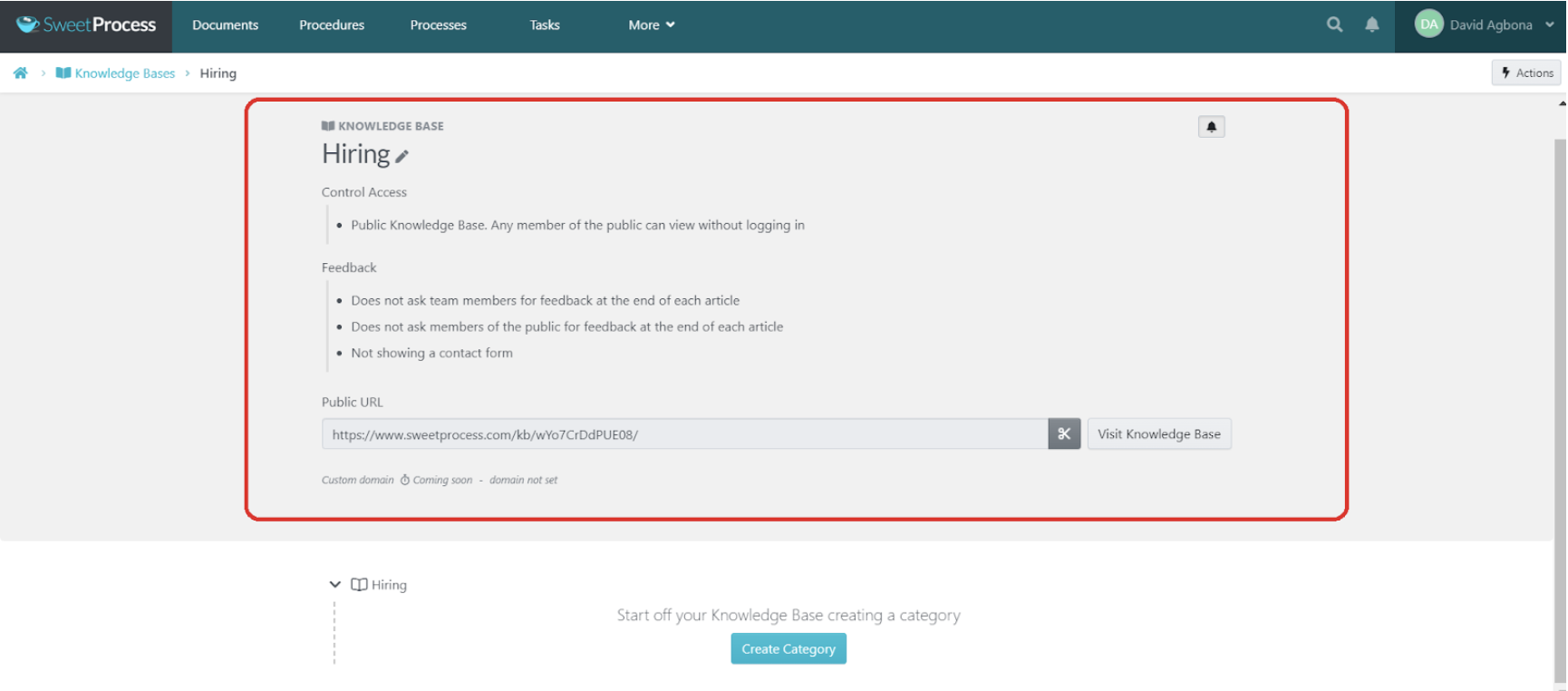
To create your knowledge base, scroll down to “Create Category.”
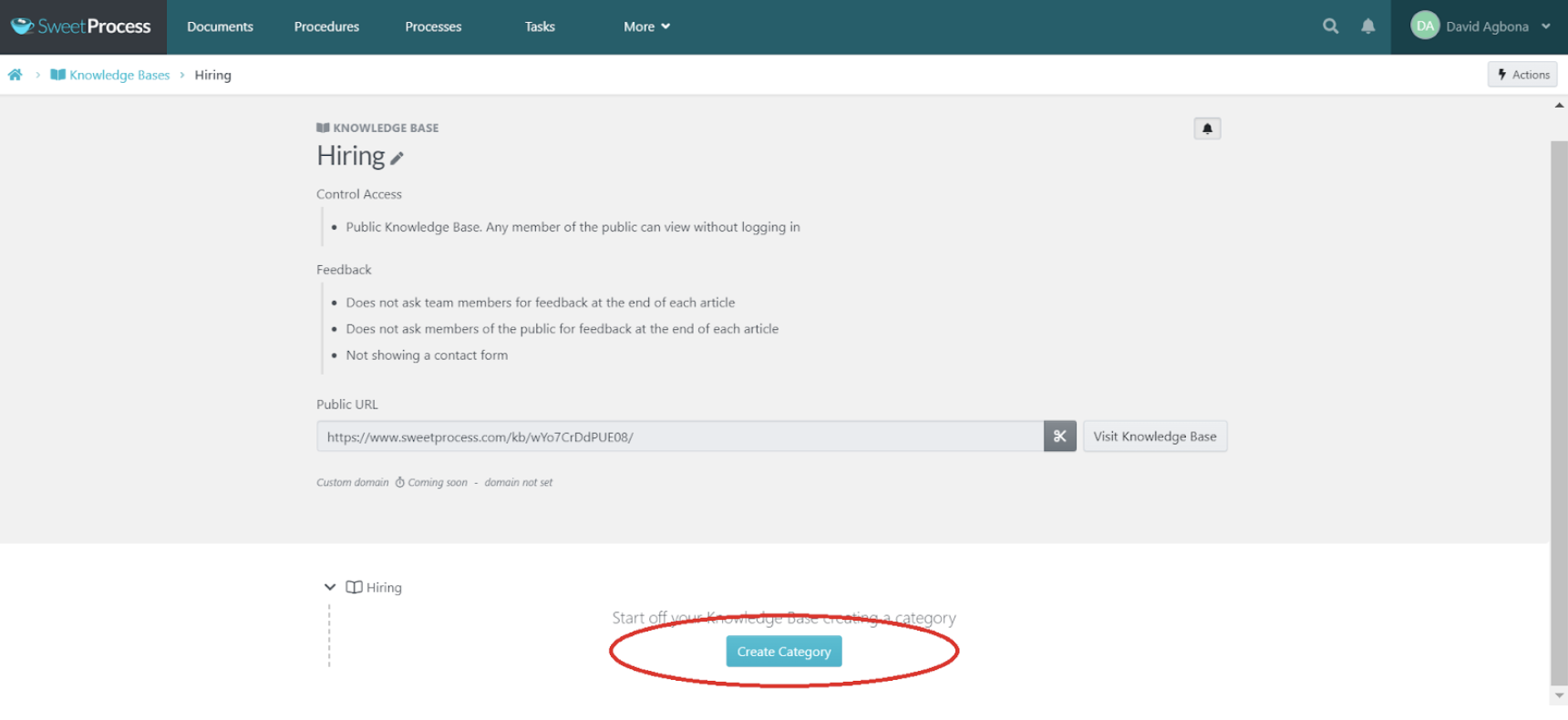
Step 4
Create and name a category.
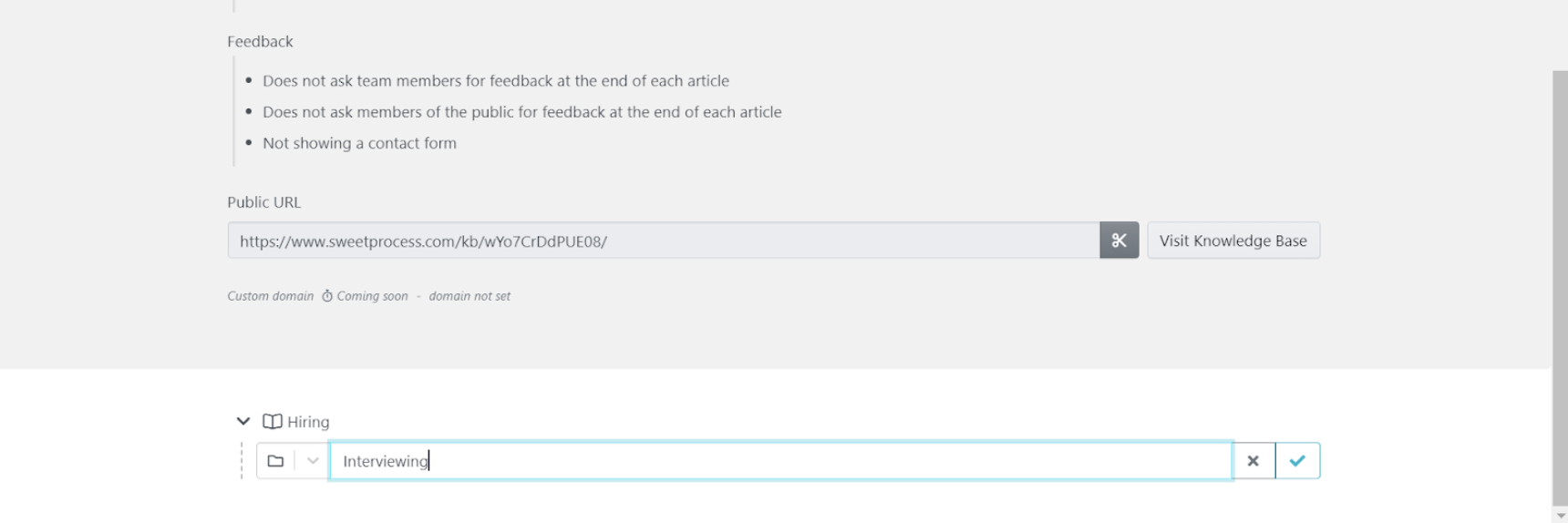
Step 5
Add an article under the category, and you’re good to go.

The only things you can add as articles are procedures or policies that you’ve completed and approved.

Unlike the processes and procedures that you need to approve, the changes you make to the knowledge base are updated and available to be viewed when you’re done with them.
Pricing
At $99/month for a small team of 20, this only amounts to about $5 per/team member/month.
Even better? If you make an annual payment, you save 16% and pay $82/month for a team of 20, which ends up being about $4/team member/month.
Did you like everything you saw? Try SweetProcess absolutely free for 14 days.
We won’t even ask for your credit card details.
Process Street
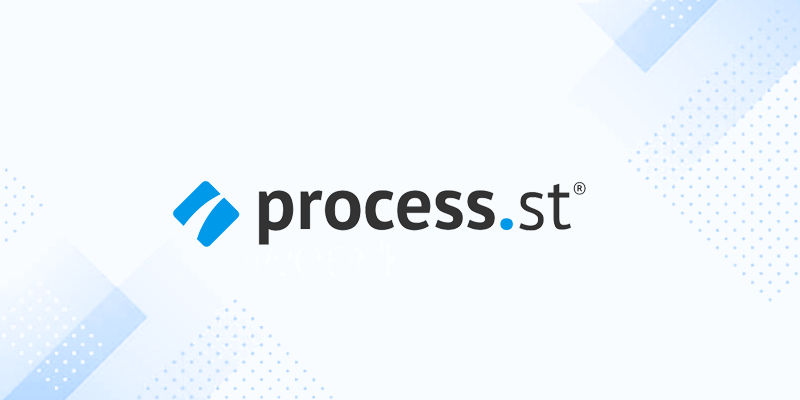
Process Street is a robust workplace management tool to manage routine procedures. You can use it to create, automate, update, and manage your team’s processes remotely.
The platform was designed for non-technical users, so it comes fitted with features that make it versatile. One of these features is an array of templates that users can customize and the ability to integrate with more than 1,000 third-party apps.
In addition, you can create procedures easily with the software’s drag-and-drop feature. You can also add rich media (including images, attachments, and videos) to procedures and tasks.
On the platform, there is comment-based communication and role-based access through different user roles, including admin, guest, and member. It also has a superb notification system that keeps team members abreast of all information related to workflow processes.
Process Street uses a conditional logic functionality that makes it easy to create transparent processes anyone can follow. It also works perfectly for people who want to take the minimalist approach and use the platform solely for creating simple checklists.
Pricing
Process Street has a free version that allows limited functionality for one user. With this free version, you can access all the platform’s core features to set up workflows.
You can upgrade to the paid plan for $25/member/month if you want more from the platform. This plan gives you unlimited storage, workflows, and more than 500 integration actions/month. You can try the paid plan for free to decide if it’s a fit.
Finally, there is a custom enterprise package for teams that want more. You get everything the paid plan offers, plus unlimited integration actions, personalized team training, API access, fully managed workflows, and bulk document import.
Pros
- Easy to use with tutorials and guides
- Great customer service
- Easy to customize and manipulate to get your preferred results
- It provides an overview that allows you to see the timeline of your progress easily
- It has an excellent user interface (UI)
Cons
- Limited options for organizing complex conditional logic settings
- Limited options for copying and pasting from one workflow to another
- Not having all the right add-on features when editing templates
Who It Is Best For
Process Street is a great Scribe alternative and is best for small, medium, and large businesses.
- Compare the process documentation features of SweetProcess and Tango, another screen-capturing software
ProcedureFlow

ProcedureFlow is a cloud-based knowledge management system that allows companies to leverage knowledge from their top employees and make that knowledge accessible to everyone.
ProcedureFlow is simple to use; however, it is robust enough to allow for creating and updating detailed and organized standard operating procedures for an enterprise.
Every small or growing business struggles with inconsistencies in its operating procedures. ProcedureFlow allows businesses to standardize and document their processes online and update them if necessary.
Big businesses can also benefit from using ProcedureFlow. Many large enterprises have lost years of knowledge due to employee turnover because they store their SOPs on paper, in the minds of top employees, or on a computer somewhere.
This way, many important details go undocumented. With ProcedureFlow, you can easily document any information, whether it’s for simple tasks or departmental workflows. All this information can be accessed, managed, and updated when necessary.
Features
- Centralized processes: All the organization’s processes are centralized and structured according to departments.
- Collaborate and share: With this feature, anyone in the organization can suggest improvements on the platform. When the improvement is approved, it becomes the business’s standard operating process.
- Easy navigation: With shapes and visual flow, you can navigate complex workflows and processes and understand them at a glance.
Pricing
There are two pricing tiers on ProcedureFlow. The first one costs $25/member/month. On this plan, teams can change notifications, create linked visual flows and run side-by-side visual comparisons. ProcedureFlow allows for a demo of their software.
If you aren’t satisfied with the first tier, you can request a custom package. You get all the benefits of the paid package, plus extra features.
Pros
- Excellent software interface and functionality
- Great customer support
- Easy navigation with visual flows
- Easy for employees to share and update the knowledge base
- One-point process management and visualization system
Cons
- No option to print task lists for team members who don’t always have access to a computer
- Not-so-impressive user management features
- No autosave feature
Who It Is Best For
ProcedureFlow is well suited for small and growing businesses, even though large enterprises can benefit from its features. Its easy visualization and use make it one of the best Scribe alternatives.
Way We Do

Way We Do is an SOP (standard operating procedure) software that helps businesses and large enterprises create, update, and manage SOPs online and in real time. The platform helps turn static policies, procedures, and checklists into an interactive and automated workflow assistant.
It is a cloud-based platform and so team members can access tasks, checklists, and procedures conveniently, and most importantly, remotely.
The platform provides a progress status on all tasks, showing tasks team members have completed and others they haven’t. This way, team members can hold each other accountable.
Features
Way We Do has many features that make it an excellent buy. Some of them are:
- Activated Checklists: With Activated Checklists, team members can systemize their workflows. These act as a guide to help complete testings, evaluations, and audits. Activated Checklists help make tasks more visual and exciting while letting you monitor progress remotely and in real time.
- Organization charts: Organization charts make it easy to design and illustrate your company structure by basing it on roles instead of people. With this structural understanding, businesses can plan for expansion, and team members can easily see their responsibilities.
- Authoring procedures: With this feature, you can create procedures your team uses daily. This feature comes with many templates and already existing written procedures that you can edit. This adds up in massive time savings.
Pricing
The entry price for Way We Do is $99, allowing you to add up to 10 team members. You get unlimited procedures and processes on this plan and standard support. You can request a free trial to see if it works for your team.
There is also a custom enterprise plan with some extra features. For example, you get dedicated support and can add up to 50 team members.
Pros
- Great management tool for teams
- Provides a holistic approach to the use of procedures and policies
- Allows teams to stay accountable and monitor processes
Cons
- Price is a bit high for small businesses with medium to large teams
- Limited SOP templates
Who It Is Best For
Way We Do works for all businesses except freelance businesses. Small, medium and large businesses can benefit from this SOP software.
Process Bliss

Process Bliss is a task management tool, a centralized platform where users can create, modify, and implement standard operating processes across the organization.
Process Bliss aims to help teams standardize their processes so they run like clockwork without management having to interfere and oversee them. This reduces friction and keeps team members accountable. It also provides a birdseye view of processes, allowing you to see the progress status of processes and it exposes areas where performance can be improved for optimal results.
Features
Some of the essential features of Process Bliss are:
- Template library: A template library allows you to create templates to help with important processes. You can embed videos, links, and files, add drag-and-drop flowcharts, decisions and loops, dependent due dates, etc.
- Collaboration: You have unlimited guest access for your team members. You can comment and tag your teammates to view and respond to different tasks.
- Task management: Process Bliss has to-do managers, notifications, reminders, snooze, schedules, etc., that make it easy for you to manage tasks.
Pricing
There is just one pricing tier on Process Bliss, costing $10 per user per month. If you pay annually, you get two months free. Also, there is a 40% discount for charities or educational organizations.
This package comes with unlimited access to all features. You get unlimited templates, workflows, tasks, guest access and groups.
In addition to the regular features on the different packages, there are other implementation options where you pay experts to help you implement the package seamlessly.
Pros
- Great for quicker onboarding of new employees
- Centralized information hub
- It can be used on all devices
Cons
- It is a bit slow and glitchy at times
- Fewer features compared to alternatives
- Clunky notifications system
- API could be more robust
Who It Is Best For
Process Bliss is great for small and medium businesses and freelancers.
Waybook

Waybook is a cloud-based knowledge management tool for documenting training, onboarding, and reference material in one place. It is another excellent alternative to Scribe.
You can access all your guides, processes, and procedures from Waybook.
Like a mini Wiki, you can search for information to help with tasks. It is also a good learning management system (LMS). You can add learning, development, and onboarding programs for your staff on the platform.
Finally, it allows integrations with over 3,000 apps for a smooth workflow. These apps include Google Drive, YouTube, Dropbox, Giphy, Unsplash, Loom, Zoom, Slack, and Zapier. You can also embed videos, PDFs and other files in your processes and training programs.
Features
There are many features of Waybook that make it a worthy Scribe alternative. They are:
- Integrations and embed functionality: You can integrate with other apps and platforms for better project management. Also, you can embed links, videos, and other important data files into your processes.
- Quick search: Waybook provides knowledge base functionality. You can quickly get what you need, whenever you need it.
- Record and edit screen recording: Like Scribe, you can record your processes and edit them for the rest of your team to learn, modify, and use for their tasks.
Pricing
Waybook costs $99 per month for 20 users. If you choose to be billed annually, you’ll pay $83 a month. For every new user, you pay $5 per month per user.
For this package, you get:
- A custom domain
- All templates
- Due dates
- Progress tracking
- Shareable subjects
Pros
- Easy integrations with other related platforms
- Highly functional search option
- Excellent LMS for training and onboarding programs
- Excellent knowledge base for organizations
Cons
- Exporting numerous documents at a time can be a hassle
- Limited text editing features
- No multi-language feature
systemHUB
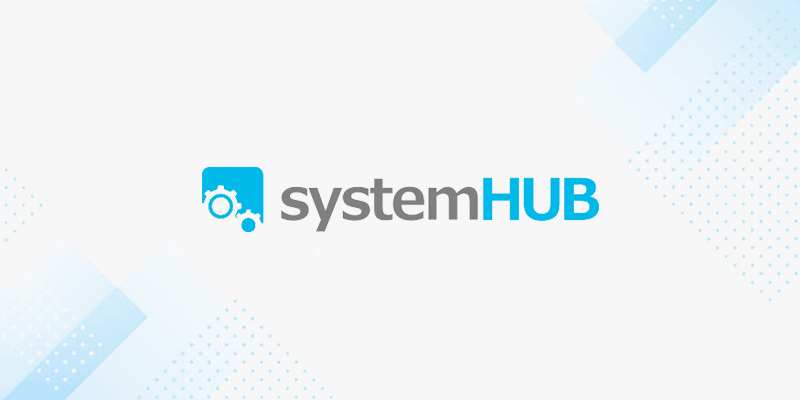
SystemHUB is a cloud-based business management tool that helps business managers and team leaders to centralize every aspect of the business. This way, they can stay on top of all operations without having to micromanage everything.
This platform allows managers and team leaders to create, modify, and implement custom workflows, standard operating procedures, and rules. This way, all tasks and processes are streamlined, and human intervention is minimal.
Usually, teams spend a lot of time struggling with processes that should have been established. This leaves little time to think about scaling and growing. With systemHUB, you can document your business’s best practices so that your teams and departments can duplicate them repeatedly. These practices can also be corrected and modified over time so that tasks and processes can improve.
SystemHUB is not another file storage system like Google Docs for writing and storing SOPs. It is a robust management system with better features like highly advanced search and easy tagging/commenting.
Features
Many features make systemHUB unique and comparable with other tools like Scribe. Some of them are:
- Templates library: You can copy proven SOPs, systems, and policies from their template library. With templates, most of the hard work is out of the way. All you have to do is tweak to your taste.
- Custom sharing: You have complete control of who you allow to see, edit, or create SOPs.
- Organized systems: SystemHUB organizes all your company’s information in one central location so you can access them easily. Thanks to this feature, your systems, SOPs, and processes are not scattered all over the place.
Pricing
There are three packages on systemHUB. The first one is the Starter package which is also the most popular. It costs $79 a month for 10 users, but if you choose to pay for a year, you save $358.
The second package, called the Growth plan, costs $119 per month for 20 users. In addition to the unlimited storage offered on the first package, you also get access to templates for SOPs and training. If you choose to be billed annually, you will save $433.
The third and final package costs $199 monthly for 40 users and is called the Scale plan. Choosing the annual billing plan will give you access to 40 business systems summit templates and help you save $593.
Pros
- Saves money and time with templates library
- It has a user-friendly design
- Allows for easy system optimization
Cons
- It only supports apps for Windows devices
- Steep learning curve
- Not ideal for large enterprises
Who It Is Best For
SystemHUB works perfectly for small and medium businesses.
Dozuki

Dozuki is the leading standard work instruction and employee training software for industrial and manufacturing companies. With Dozuki, manufacturers can create and implement standardized operating procedures and training efforts for excellent results.
In the manufacturing industry, monitoring equipment and procedures without being on the ground to manage every step of the process can be challenging. It is even harder to update existing operating procedures and train employees on new best practices.
Dozuki gives managers and team leaders in manufacturing the ability to manage every aspect of the factory from a single place. All the equipment is tagged with barcodes and logged into the cloud-based system, the same as operating procedures for all processes.
The platform also allows for more than just texts containing processes. You can scan a piece of equipment and see instruction videos on operating or repairing specific parts. These tutorial videos are similar to those created on Scribe.
Features
Some of the critical features of Dozuki are:
- Work instructions software: You can easily create, modify, and implement instructions using Dozuki. Like Scribe, you can make tutorial videos or guides that specifically tell employees how to handle different equipment in the factory or plant. All they have to do is scan the barcode for the equipment, and they’ll be able to access the work instructions for that equipment.
- Quality management: You can manage and improve your quality with Dozuki thanks to the easy update and approval process of SOPs. Experts can control and approve every step of every process in the work instructions and improve them.
- Workforce training: Dozuki makes it easy and cheaper to train and cross-train your employees on the job. With tutorial videos and guides that can be modified and updated, your employees can handle the most demanding tasks without needing you to be present every time.
Pricing
Dozuki has a peculiar pricing model that reduces the price per user as the number of users increases. For the basic plan, a minimum of 50 users are required. It costs $17 per user and is great for companies looking for a light digital transformation.
The next plan is the Essentials plan, which requires at least 120 users. It costs $14 per user per month.
The Premium plan is the most popular, requiring a minimum of 250 users. It costs $12 monthly per user.
Finally, the Enterprise+ package requires a minimum of 400 users and costs $10 per user per month.
Pros
- It is easy to create work instructions videos and guides on the platform
- Highly intuitive and user-friendly design
- Great and friendly customer support
Cons
- The process of validation of work instructions takes some time to implement
- No autosave feature
- Limited template formats
Who It Is Best For
Dozuki works best for manufacturing companies or companies with many equipment and staff handling the equipment.
Whale

Whale is a cloud-based knowledge-sharing tool that makes it easier to train and onboard employees while implementing processes and procedures.
Other employees can also modify centralized processes and, after approval, turn them into best practices for the company. This way, your company continues to grow and scale its knowledge base without the hassle of digging up old files and changing them.
If you are having a hard time creating workflows and processes, there are templates on the platform that you can use as inspiration to start. You can edit other details as you go.
The software has received many accolades from review websites like G2, SourceForge, and Slashdot for their high performance and excellent support team.
Features
- Create: You can create SOPs, playbooks, guides, etc., on the Whale platform. The “create” feature on the platform is robust, allowing you to break processes into bite-sized data. You can also embed links, videos, pictures, etc., to make your guides easier to understand.
- Train: With this feature, you can transform SOPs, guides, and other resources into comprehensive manuals for training and streamlining the intake process for onboarding employees. You can easily add assignments, create structured learning flows, and track completion to ensure a smooth and efficient training experience.
- Manage: Whale’s “manage” feature allows you to manage all your team’s processes and close knowledge gaps where they exist. This way, all your team members and employees are always on the same page.
Pricing
There are three pricing plans on Whale. The first one is called the Starter plan, and it costs $1 per seat per day. It is for people who want to test the software for a day. You get all features plus the browser integration.
The second plan is the Growth plan, which costs $12 per seat per month, with a minimum of 10 seats. All features here are similar to the Starter plan.
Finally, the Scale plan charges you based on your enterprise needs.
Pros
- Easy to learn and user-friendly
- Excellent customer service and support
- Excellent suggestions functionality
Cons
- Pricing is a bit higher than competitors
- Limited role-based access functionality
- Little variety in template options
Who It Is Best For
Like Scribe, Whale is best for small and medium-sized businesses.
Manifestly

Manifestly is an integrated checklist software solution for teams and businesses. Its main objective is to help teams with recurring tasks to focus on carrying out their assignments rather than recreating checklists from days or weeks before.
On the platform, team members rely on a streamlined Slack integration to help with easy communication. The checklist tool in the app is connected to the communication tool so that managers and team leaders can monitor team activities without sending emails.
Manifestly also allows for Zapier integration, so teams can do more to enhance their workflows without relying on just one interface. Many other integrations allow seamless workflows and communication between team members and managers. These integrations allow managers to assign, modify, and supervise tasks easily.
Features
- Checklist scheduling: You can schedule daily, weekly, or quarterly checklist runs to ensure that recurring tasks are completed when due. This feature sends notifications for checklist status, like when a checklist is running or completed.
- Seamless integrations: You can integrate Manifestly with the services you already use. Some integrations allowed on the Manifestly platform include Slack, Zapier, GitHub, Zendesk, Stripe, The People Platform, Intercom, Salesforce, Zoho, Gmail, Mailchimp, and many others.
- Open API: If you have a particular software built for your business only, you can integrate it with Manifestly. Manifestly has an open API to build your own integrations and connect them directly with your own application or website.
Pricing
There are two pricing packages on the Manifestly platform. The first one is the Starter package which is free. However, you only get six checklist runs per month and 50 MB of file storage.
The second package called the Business package, costs $8 per user per month. You get unlimited checklist runs and 5 GB of file storage. In addition, you get five free spaces for limited users for every business package user.
Pros
- It has robust integration and open API to help businesses integrate with as many communication channels as possible
- It is available on all devices
- Its pricing plan is relatively affordable
Cons
- It is solely focused on checklists and not on other business management services
- Pesky notification system
- Archaic user interface design
- Takes time to get used to
Who It Is Best For
Manifestly works best for small and medium businesses. Exporting numerous documents at a time can be a hassle.
- You may want to compare more screen recording tools. Check out this detailed post we wrote on Scribe Vs Loom
The proof is in the pudding: How a CEO Reduced Employee Turnover with SweetProcess

Our software can handle all your process documentation needs and help you do more meaningful work. But don’t take our word for it.
Listen to Amy Walls, president and financial advisor at Thimbleberry Financial, who says, “Our employees have never gone through a more organized onboarding process.”
Before, things weren’t so rosy at Thimbleberry. Processes weren’t documented properly and what resulted was a disturbing turnover rate. There was no reference material, a resource that Amy could point people with questions.
She wore too many hats.
But now, things are different. Employees at Thimbleberry can begin working on the first day because everything is so organized.
And by using SweetProcess, they have managed to streamline their training process.
These days, collaboration is easier too, because she can use role-based access to delegate tasks and get things done even when she’s absent.
Read the entire case study here.
- There are other alternatives with features similar to those of Scribe. Hence, we have compared Scribe Chrome extension and Tango Chrome extension in this detailed post.
You Got Here? Sweet!
That was a long list full of features and pros and cons.
But you now have the information to help you decide which software solution is the best Scribe alternative for your business.
We recommend you start here: try out SweetProcess for free for 14 days.
We won’t ask for your credit card details. You only need to create an account with just your name and your best email.
Wait…
What if you wanted to migrate, and you’re wondering how you’ll survive the Herculean task of migrating and organizing all your procedures and policies in SweetProcess?
Just get in touch. We can help you with that too!
Sign up here.
